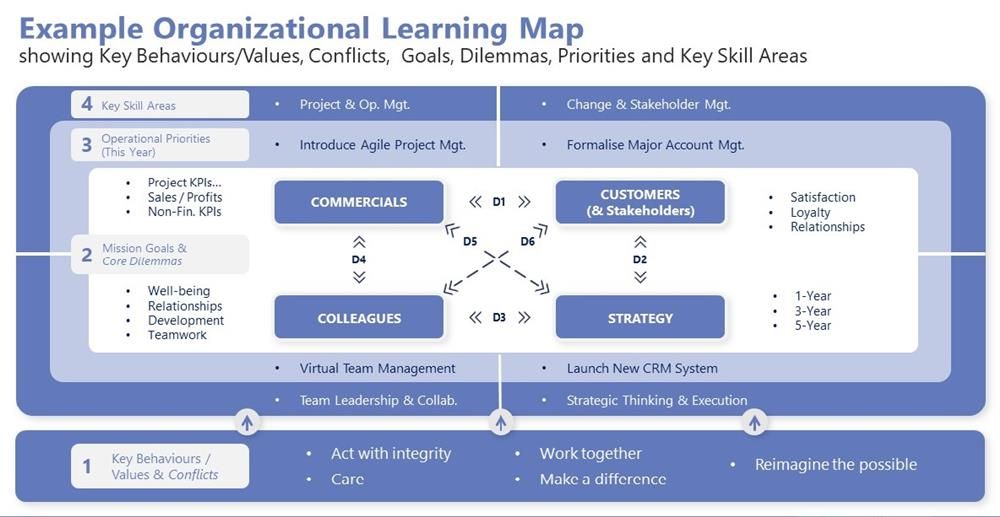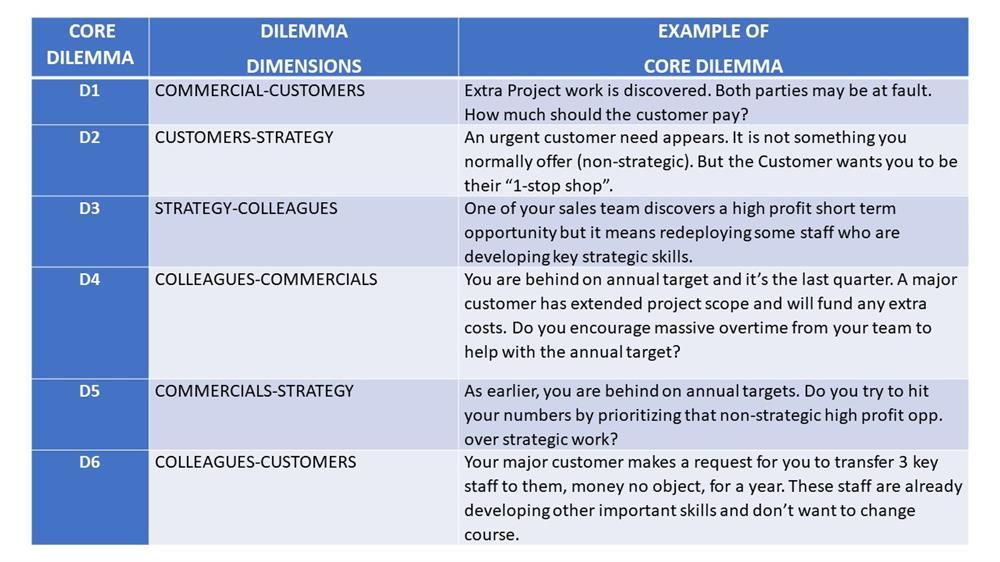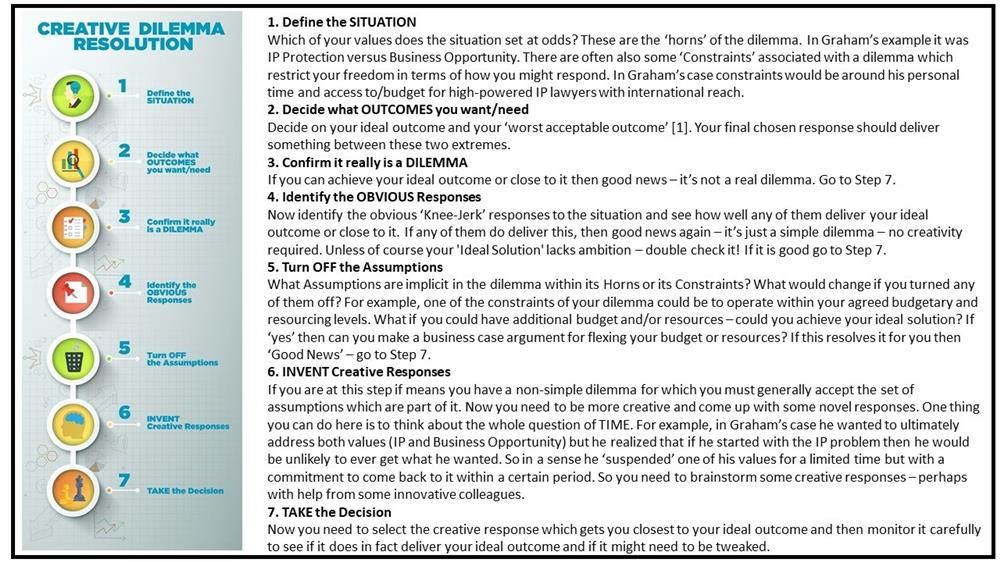Using learning maps to design better leadership development programmes
By Ken Thompson, Oct 11, 2021 Last updated Aug 19, 2025
This article introduces learning maps and explains how you can use them to quickly design (or check) learning programmes for any kind of organisation. You can also use learning maps to design custom learning sessions anchored around key organisational priorities. The learning map approach guarantees your development programmes address the most important areas for the different learner groups in your organisation.
Learning maps can be used to design any type of development programme (face-to-face or virtual) including:
- Induction programmes
- High potential programmes
- Development centres
- Management development programmes
- Senior leader programmes
You can quickly adapt the example learning map shown below as a template to create an overarching design for your specific organisational learning programme.
See the end of this article for how to obtain an editable version of the learning map.
The four territories on a learning map
There are four key “territories” on a learning map:
- Key behaviours, values and conflicts
- Mission goals and core dilemmas
- Operational priorities (12-month horizon)
- Key skill areas
In the figure below we show an example learning map for a major consulting organisation.

All four territories need to be covered in your learning programme (obviously not all at the same time) if it is going to provide the learning your colleagues need. Sadly, too many learning programmes focus only on the key skill areas and operational priorities and omit the organisational goals and key behaviours and values.
Note that key behaviours and values underpin everything on the learning map, whereas key skill areas support specific areas of the map such as the customer aspect.
Let’s explore each learning map territory in more detail.
1. Key behaviours, values and conflicts
These are key positive behaviours that the organisation has decided it wishes to see and promote in each person who works there. They are usually highly specific to each organisation and typically cover five to eight specific behaviours. Your organisation has probably already defined them!
It is also important to identify any potential conflicts between these values, as this can be an ongoing source of problems which should be addressed in development using appropriate scenarios. Values conflicts are often entirely necessary in real life – they cannot be avoided – but staff need to develop skills in managing them.
For example, when might “working together” take precedence over “re-imagining the possible” and vice versa? An example of the first case is avoiding an overly siloed or “solo run” approach to an opportunity, whereas an example of the second case is avoiding “groupthink” in creatively addressing a challenging problem.
To better understand the inevitability of values conflicts, just reflect for a moment on Marianne, the motto of the French Republic – “Liberté, Égalité, Fraternité” – and all the possible conflicts which arise between these three important values in French society.

2. Mission goals and core dilemmas
Any commercial enterprise can define its mission goals in terms of just four dimensions:
- Commercials
- Customers
- Strategy
- Colleagues
Some commercial enterprises may decide to split customers into two separate dimensions – customers and stakeholders. Stakeholders cover important parties such as shareholders, regulators, community and the environment, and may merit their own category in certain types of regulated industries.
This customer–stakeholder split can also be important for non-commercial enterprises, who may also rename the commercials dimension as operations to better reflect their core outputs.
Core dilemmas
Core dilemmas are a direct consequence of the mission goals. Managing these dilemmas well is often the difference between success and failure for individuals in the organisation. And yet, amazingly, they are often completely absent from organisational learning programmes.
If you have four dimensions you have six core dilemmas (and if you have five dimensions you have eight core dilemmas). It is very important to create a set of concrete examples of real core dilemmas as a source of rich learning scenarios – here is a set of examples for the major consulting organisation:

Three important skills in managing core dilemmas are:
- Dilemma recognition
If you don’t recognise the dilemma, then you are unlikely to be able to address it successfully. - Creative dilemma resolution
This is where you try to design a solution to the dilemma that is more creative or co-inventive than the obvious compromise response.

(from "A Systematic Guide to Business Acumen and Leadership Using Dilemmas")
- Values debt management
This is where you always try to acknowledge where you have “short-changed” one of your key values or mission goals and develop concrete plans for paying back the “values debt” as quickly as possible.
Here’s an example – imagine a cruise ship. A common mission goal dilemma is between guest satisfaction and crew morale. Often crew morale gets sacrificed to address unexpected issues in guest satisfaction. This results in leaders accumulating debts – in this case you are now in debt to crew morale. Good leaders repay these debts as quickly as possible, but weak leaders build up “bad debts” in certain values which eventually come back in a way which can no longer be ignored and can have serious consequences.
Note also that some of these core dilemmas can turn into “tri-lemmas”, e.g. colleagues–customers–commercials, making them even more difficult to navigate successfully.
Hopefully you can now see why the ability to deal with values conflicts and core dilemmas is so critical to the success of leaders and managers in any organisation, and why these tensions need to be addressed explicitly in staff development programmes.
3. Operational priorities (12-month horizon)
This is exactly as it says in the title – operational or organisational urgencies which are being addressed within the current fiscal year and which may have implications for staff development.
4. Key skill areas
Key skill areas are derived by identifying what skills need to be developed to support the other three dimensions of the organisational learning map, namely:
- Key behaviours, values and conflicts
- Mission goals and core dilemmas
- Operational priorities (12-month horizon)
Create your own organisational learning maps
You can create a unique set of learning maps for your organisation if you follow the five steps below:
- Step 1: Review
Review and edit the four territories and four dimensions of the learning map to reflect your own organisation. - Step 2: Identify
Identify the different learning groups or communities in your organisation and their skill needs.
For example, team leadership means different things for a junior project manager compared with a senior manager (whose team members may all be leaders of teams themselves). Each learning group needs its own version of the learning map – at least in terms of the key skill areas. - Step 3: Prioritise
Prioritise and phase how you will package up the different learning components for each learning group. You cannot deliver them all in one go, so decide which ones you need to address first. - Step 4: Summarise
Prepare a one-page map for each learning group. Each group’s map may have a different set of priorities and phasing, plus different content levels for key skill areas. - Step 5: Plan/design
Plan and design the different learning delivery modes, mechanisms and methods.
This will depend on various factors such as the size of each group, their work patterns and their roles in the organisation. You will also have to consider the most appropriate modes (individual, group or team), mechanisms of development (classroom, e-learning or simulation), and methods (self-directed or facilitated) for each learning group.
The benefits of learning maps
Learning maps are a fast and effective tool for designing new learning programmes and sanity-checking existing programmes for gaps. Learning maps are also extremely useful to fast-track the design of specific programme elements using scenario-based learning tools such as configurable business simulations.
Counterintuitively, it is the conflicts between the key behaviours/values and the conflicts between the mission goals which often provide the richest learning scenarios, offering the most valuable development opportunities in organisations.
More information
If you would like an editable version of the example learning map in this article, just get in touch.
We can also provide information on tools for converting learning maps into online business simulations to enhance your leadership development programmes.
